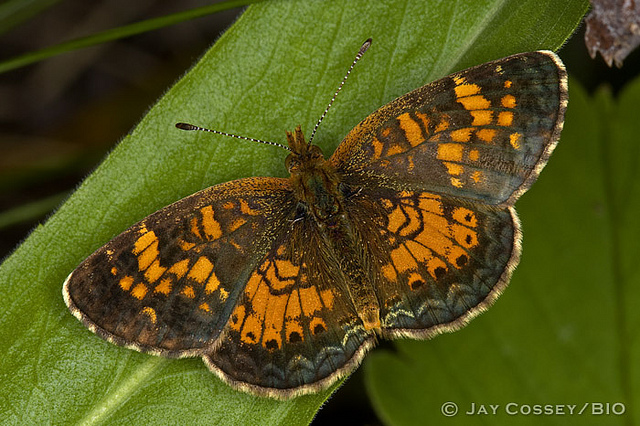Map Snapshot

3 Records
Status
Tawny Crescent (Phyciodes batesii) was formerly believed to have occurred in and been extirpated from Maryland, specifically from Montgomery County. Its inclusion as part of the Maryland butterfly fauna rests solely on a reference from Austin Clark in his 1932 The Butterflies of the District of Columbia and Vicinity, where he notes he collected specimens of batesii in 1925 and 1929 near Cabin John. Based on contemporary and historical observation data for Tawny Crescent, however, these data are almost certainly in error, and the specimens Clark collected have been lost. The butterflies he saw were most likely of the Northern Crescent complex (the Phyciodes cocyta group) and not batesii. Currently, the primarily northern Tawny Crescent is known in the Appalachian Chain from just a few relict populations in the mountains of North Carolina and Georgia. It still ranges widely in the north and portions of the west (Brock & Kaufman, 2003; Glassberg, 1999). (R. Borchelt, pers. comm.)
Relationships
Reported to use Wavy-leaved Aster (Symphyotrichum undulatum) as a larval host. May use other species as well (Allen, 1997).
Seasonality Snapshot
Source: Wikipedia
| Phyciodes batesii | |
|---|---|

| |
| Ottawa, Ontario, Canada | |
| Scientific classification | |
| Domain: | Eukaryota |
| Kingdom: | Animalia |
| Phylum: | Arthropoda |
| Class: | Insecta |
| Order: | Lepidoptera |
| Family: | Nymphalidae |
| Genus: | Phyciodes |
| Species: | P. batesii
|
| Binomial name | |
| Phyciodes batesii (Reakirt, 1865)
| |
| Subspecies | |
| |
Phyciodes batesii, the tawny crescent, is a butterfly of the family Nymphalidae that occurs in North America.
Description
[edit]The upperside is dark brown with orange and the forewing has a pale postmedian band with submarginal bands. The female's black submarginal band has dots. Both sexes have black and white antenna knobs. The wingspan is from 25 to 38 mm.[2]
Life cycle
[edit]Adults fly once a year between May and July. There is sometimes a partial second brood in Michigan. During this time the females lay their eggs in groups on the host plants.[citation needed] The fourth-instar caterpillars hibernate.[1]
Larval foods
[edit]Adult foods
[edit]Similar species
[edit]- Phyciodes cocyta – northern crescent
- Phyciodes tharos – pearl crescent
References
[edit]- ^ a b c d NatureServe (1 December 2023). "Phyciodes batesii". NatureServe Network Biodiversity Location Data accessed through NatureServe Explorer. Arlington, Virginia: NatureServe. Retrieved 20 December 2023.
- ^ Tawny Crescent, Butterflies of Canada
- "Species Phyciodes batesii - Tawny Crescent". Retrieved 2008-11-18.
- "Phyciodes Hübner, [1819]" at Markku Savela's Lepidoptera and Some Other Life Forms
- "Tawny Crescent Species Detail". Retrieved 2008-11-18.

